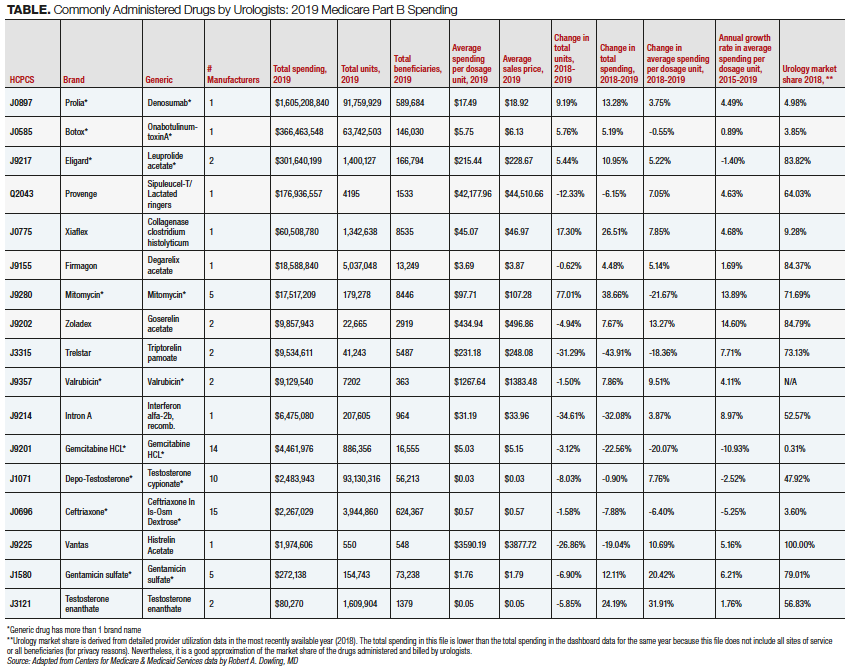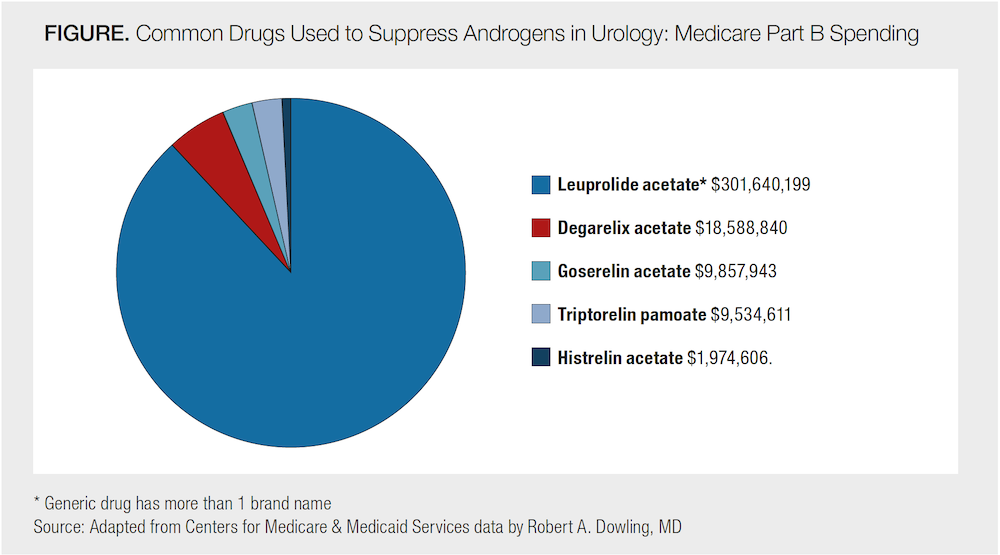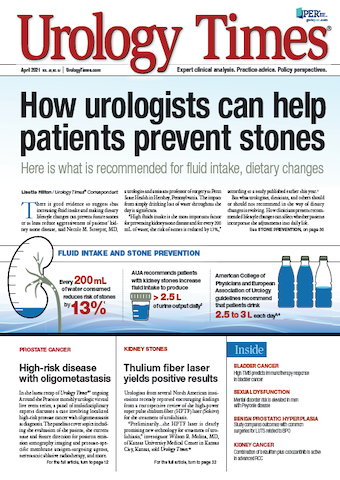Publication
Article
Urology Times Journal
Part B data reveal increased usage of denosumab and mitomycin
Author(s):
Leuprolide acetate remains the most commonly used androgen suppression drug.
Robert A. Dowling, MD

Growth in drug costs and spending for Medicare beneficiaries remains an area of concern for patients, policymakers, providers, payers, and regulators. The concerns exist in part because of a perception that the current reimbursement system encourages overutilization and price increases. According to the Centers for Medicare & Medicaid Services (CMS), between 2006 and 2017, Medicare Part B fee-for-service drug spending per enrollee grew at 8.1% annually, more than twice as high as per capita spending on Medicare Part D (3.4%) and nearly 3 times as high as overall retail prescription per capita drug spending (2.9%).1
Spending is not increasing for all Part B drugs; in an article last year citing 2018 spending data, I reported that of 17 Part B drugs commonly used by urologists, only 3 drugs increased in spending faster than Part B spending overall.2 In fact, spending on a small number of specialty drugs is driving most of the increases through high prices, high utilization, or both.
Nevertheless, in 2020 CMS finalized a new “1 size fits all” rule—the Most Favored Nation Model for Medicare Part B Drugs and Biologicals—wherein it proposed indexing payments for Part B drugs to the reduced amounts paid by peer countries and testing a flat add-on fee to replace the current model of average sales price plus a percentage. This proposed rule would have a large impact on urology and oncology practices and met fierce resistance from a number of associations; at the time of this writing, CMS has not appealed an injunction that halted implementation of the rule. In this article, I will update the spending and costs for Medicare Part B drugs commonly used by urologists in the office setting in the context of even greater scrutiny by policymakers and regulators.
CMS recently released detailed drug spending data for 2015 to 2019.3 “Spending” in this context includes the estimated total costs, such as deductible, coinsurance, and Medicare spending. Total spending in 2019 for 585 Part B drugs was $37.3 billion, up more than 12% from 2018.3 (Note that CMS revised 2018 total spending figures in 2019; using the revised figure, spending increased over 18%.) Spending on any single drug may increase because of increased utilization, higher price, or both. Although it is not possible using this particular data set to determine what fraction of total spending is accountable to urologists, or the spending by indication for any individual drug, we can examine trends in the drugs commonly administered and billed by urologists in the office setting.
Denosumab has largest total spend among urologists
Seventeen drugs commonly used by urologists account for less than 7% of total Medicare Part B drug spending. Of these 17 drugs used in the urology office for Medicare beneficiaries (Table), the drug with the largest 2019 total spend—as in 2018—was denosumab (Xgeva) at $1.6 billion; in 2019, utilization for denosumab increased 9.2%, spending per dose increased 3.75%, and total spending increased 13.3% compared with 2018. Denosumab spending has increased 4.5% per year over the last 5 years. (In a separate data set of provider utilization data, urologists account for 5% of denosumab spending.4) The drug with the largest annual growth in spending per dose unit (price) among this selected group was goserelin acetate (Zoladex) with 14.6% annual growth over the last 5 years. Utilization of mitomycin in 2019 increased sharply from 2018 (77%), possibly due to urologists’ use as an alternative during the BCG shortage. Total spending for mitomycin increased 38.7% over the previous year—the largest increase in this family of 17 drugs. Gemcitabine utilization in 2019 was down more than 3% compared with 2018.

Ten of these 17 common drugs showed increased spending in 2019 over 2018. The spending was driven primarily by increased utilization in 5 (mitomycin, collagenase clostridium histolyticum [Xiaflex], denosumab, leuprolide acetate, and onabotulinumtoxina A), and increased price in 5 (testosterone enanthate, gentamicin sulfate, valrubicin, goserelin acetate, and degarelix acetate). Among the 7 drugs where spending declined in 2019 over 2018, it was mainly because of decreased utilization in 5 (triptorelin pamoate, interferon alfa-2b, histrelin acetate, sipuleucel-T [Provenge], and testosterone cypionate) and mainly to decreased average price in 2 (gemcitabine HCL and ceftriaxone).
In the androgen suppression market (Figure), leuprolide acetate was still the most commonly administered drug with spending in 2019 of $302 million (11% higher than 2018). Over the last 5 years, growth in spending per dose of leuprolide acetate has decreased 1.4% annually. In 2019, decreases in total spending on triptorelin pamoate (Trelstar) (–44%) and histrelin acetate (–19%) were driven by sharp declines in utilization (–31 % and –27% respectively).
In general, among these 17 drugs, those with 1 or 2 manufacturers have seen higher annual growth in spending per dose (a surrogate for price) and those with 3 or more manufacturers have seen lower or negative annual growth. Mitomycin is the notable exception to this rule.

Bottom line: Urology practices continue to derive substantial revenue from administering “buy and bill” drugs, including from the Medicare Part B program. Of 17 Part B drugs commonly used by urologists, total spending in 2019 increased for 10 drugs and decreased for 7 drugs over the previous year. Price was the factor driving the change in spending in 7 drugs, and utilization in 10 drugs. Urologists should understand that unsustainable spending increases in the Part B program continue to attract the attention of CMS and other payers and should be alert for future policy changes from CMS and others.
Dowling is the president of Dowling Medical Director Services, a private health care consulting firm specializing in quality improvement, clinical informatics, and health care policy affecting specialty care. He is the former medical director of a large, metropolitan single-specialty urology group in Fort Worth, Texas.
References
1. Fact sheet: Most favored nation model for Medicare Part B drugs and biologicals interim final rule with comment period. Centers for Medicare & Medicaid Services. November 20, 2020. Accessed February 22, 2021. http://go.cms.gov/37FEp9M
2. Dowling, RA. Denosumab tops spending for common urology Part B drugs. Urology Times®. June 16, 2020. Accessed February 22, 2021. https://bit.ly/3smYA4q
3. Medicare Part B drug spending dashboard. Centers for Medicare & Medicaid Services. Updated December 22, 2020. Accessed February 22, 2021. http://go.cms.gov/2NADS1X
4. Medicare provider utilization and payment data. Centers for Medicare & Medicaid Services. Updated December 3, 2020. Accessed February 22, 2021. http://go.cms.gov/3uqMzfN

Newsletter
Stay current with the latest urology news and practice-changing insights — sign up now for the essential updates every urologist needs.































